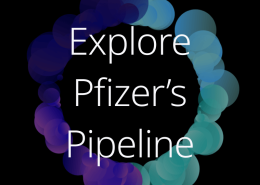Pfizer Presents Positive Real-World Evidence for First-Line IBRANCE® (palbociclib) Combination Therapy in HR+, HER2- Metastatic Breast Cancer at ESMO Breast Cancer 2022
NEW YORK, NY, May 4, 2022 – Pfizer Inc. (NYSE:PFE) announced today the presentation of real-world evidence demonstrating an associated benefit for patients treated with IBRANCE® (palbociclib) in combination with an aromatase inhibitor (AI), as compared to AI alone, in the first-line setting, at the European Society for Medical Oncology (ESMO) Breast Cancer 2022 Congress. This retrospective cohort study is a large comparative effectiveness study of 2,888 hormone receptor-positive (HR+), human epidermal growth factor receptor 2-negative (HER2-) metastatic breast cancer (mBC) patients evaluating IBRANCE in combination with AI compared to AI alone and demonstrated an associated improved overall survival (OS) in post-menopausal women and in men with HR+, HER2- mBC treated in routine clinical practice in the United States.
“Understanding the effectiveness of treatments in a real-world setting is critical to improving cancer care,” said Chris Boshoff, M.D., Ph.D., Chief Development Officer, Oncology, Pfizer Global Product Development. “Since its approval, IBRANCE has generated promising results for adults diagnosed with HR+, HER2- mBC and this latest analysis reflects Pfizer’s commitment to use real-world evidence to complement traditional randomized clinical trials to better understand the effectiveness of IBRANCE as a first-line treatment option in combination with an AI for this patient population.”
After balancing for baseline demographic and clinical characteristics, median OS (95% CI) was significantly longer in the palbociclib group versus AI group (49.1 [45.2–57.7] vs 43.2 [37.6–48.0] months; hazard ratio (HR) = 0.76 [95% CI, 0.65–0.87]; P=0.0001). Real-world median progression-free survival (95% CI) was 19.3 (17.5–20.7) versus 13.9 (12.5–15.2) months, respectively (HR = 0.70 [95% CI, 0.62–0.78]; P<0.0001) in this observational, retrospective real-world analysis. These findings represent a 24% reduction in the risk of death and a 30% reduction in the risk of progression. Safety data were not collected as part of this analysis.
“I’ve witnessed first-hand the positive impact of palbociclib in combination with endocrine therapy in patients with HR+, HER2- metastatic breast cancer,” said Hope S. Rugo, M.D., lead researcher and professor of medicine at the University of California San Francisco (UCSF) Helen Diller Family Comprehensive Cancer Center. “It is encouraging to see associated improved overall survival extend beyond my own practice in the real-world setting, and these additional results, along with clinical trial data, may help healthcare providers make more fully informed treatment decisions for their patients.”
The poster, “Overall Survival With First-Line Palbociclib Plus an Aromatase Inhibitor (AI) vs AI in Metastatic Breast Cancer: A Large Real-World Database Analysis” is on display at the ESMO Breast Cancer 2022 Congress on May 4, 2022, and can be accessed starting May 3, 2022, to those registered for the Congress.
About the IBRANCE Real-World Evidence Program
Since the initial approval by the U.S. Food and Drug Administration more than seven years ago, IBRANCE has been prescribed to more than 450,000 patients across more than 100 countries. With this breadth of real-world experience, Pfizer is working to build the most extensive body of RWE for a CDK 4/6 inhibitor. This RWE program is generating data from multiple studies involving more than 8,000 patients around the world and continues to expand. These studies – IRIS, POLARIS, MARIA, and MADELINE and others – include diverse patient populations treated in everyday clinical practice and are collecting data related to clinical outcomes, translational data and quality of life endpoints, which complement the data generated from the PALOMA randomized clinical trials. Pfizer will continue to share new data from these studies with the scientific community as results become available.
About IBRANCE® (palbociclib) 125 mg tablets and capsules
IBRANCE is an oral inhibitor of CDKs 4 and 6,1 which are key regulators of the cell cycle that trigger cellular progression.2,3 In the U.S., IBRANCE is indicated for the treatment of adult patients with HR+, HER2- advanced or metastatic breast cancer in combination with an aromatase inhibitor as initial endocrine based therapy in postmenopausal women or in men; or with fulvestrant in patients with disease progression following endocrine therapy.
The full U.S. Prescribing Information for the IBRANCE tablets and the IBRANCE capsules can be found here and here.
IMPORTANT IBRANCE®(palbociclib) SAFETY INFORMATION FROM THE U.S. PRESCRIBING INFORMATION
Neutropenia was the most frequently reported adverse reaction in PALOMA-2 (80%) and PALOMA-3 (83%). In PALOMA-2, Grade 3 (56%) or 4 (10%) decreased neutrophil counts were reported in patients receiving IBRANCE plus letrozole. In PALOMA-3, Grade 3 (55%) or Grade 4 (11%) decreased neutrophil counts were reported in patients receiving IBRANCE plus fulvestrant. Febrile neutropenia has been reported in 1.8% of patients exposed to IBRANCE across PALOMA-2 and PALOMA-3. One death due to neutropenic sepsis was observed in PALOMA-3. Inform patients to promptly report any fever.
Monitor complete blood count prior to starting IBRANCE, at the beginning of each cycle, on Day 15 of first 2 cycles and as clinically indicated. Dose interruption, dose reduction, or delay in starting treatment cycles is recommended for patients who develop Grade 3 or 4 neutropenia.
Severe, life-threatening, or fatal interstitial lung disease (ILD) and/or pneumonitis can occur in patients treated with CDK4/6 inhibitors, including IBRANCE when taken in combination with endocrine therapy. Across clinical trials (PALOMA-1, PALOMA-2, PALOMA-3), 1.0% of IBRANCE-treated patients had ILD/pneumonitis of any grade, 0.1% had Grade 3 or 4, and no fatal cases were reported. Additional cases of ILD/pneumonitis have been observed in the post-marketing setting, with fatalities reported.
Monitor patients for pulmonary symptoms indicative of ILD/pneumonitis (e.g. hypoxia, cough, dyspnea). In patients who have new or worsening respiratory symptoms and are suspected to have developed pneumonitis, interrupt IBRANCE immediately and evaluate the patient. Permanently discontinue IBRANCE in patients with severe ILD or pneumonitis.
Based on the mechanism of action, IBRANCE can cause fetal harm. Advise females of reproductive potential to use effective contraception during IBRANCE treatment and for at least 3 weeks after the last dose. IBRANCE may impair fertility in males and has the potential to cause genotoxicity. Advise male patients to consider sperm preservation before taking IBRANCE. Advise male patients with female partners of reproductive potential to use effective contraception during IBRANCE treatment and for 3 months after the last dose. Advise females to inform their healthcare provider of a known or suspected pregnancy. Advise women not to breastfeed during IBRANCE treatment and for 3 weeks after the last dose because of the potential for serious adverse reactions in nursing infants.
The most common adverse reactions(≥10%) of any grade reported in PALOMA-2 for IBRANCE plus letrozole vs placebo plus letrozole were neutropenia (80% vs 6%), infections (60% vs 42%), leukopenia (39% vs 2%), fatigue (37% vs 28%), nausea (35% vs 26%), alopecia (33% vs 16%), stomatitis (30% vs 14%), diarrhea (26% vs 19%), anemia (24% vs 9%), rash (18% vs 12%), asthenia (17% vs 12%), thrombocytopenia (16% vs 1%), vomiting (16% vs 17%), decreased appetite (15% vs 9%), dry skin (12% vs 6%), pyrexia (12% vs 9%), and dysgeusia (10% vs 5%).
The most frequently reported Grade ≥3 adverse reactions (≥5%) in PALOMA-2 for IBRANCE plus letrozole vs placebo plus letrozole were neutropenia (66% vs 2%), leukopenia (25% vs 0%), infections (7% vs 3%), and anemia (5% vs 2%).
Lab abnormalities of any grade occurring in PALOMA-2 for IBRANCE plus letrozole vs placebo plus letrozole were decreased WBC (97% vs 25%), decreased neutrophils (95% vs 20%), anemia (78% vs 42%), decreased platelets (63% vs 14%), increased aspartate aminotransferase (52% vs 34%), and increased alanine aminotransferase (43% vs 30%).
The most common adverse reactions (≥10%) of any grade reported in PALOMA-3 for IBRANCE plus fulvestrant vs placebo plus fulvestrant were neutropenia (83% vs 4%), leukopenia (53% vs 5%), infections (47% vs 31%), fatigue (41% vs 29%), nausea (34% vs 28%), anemia (30% vs 13%), stomatitis (28% vs 13%), diarrhea (24% vs 19%), thrombocytopenia (23% vs 0%), vomiting (19% vs 15%), alopecia (18% vs 6%), rash (17% vs 6%), decreased appetite (16% vs 8%), and pyrexia (13% vs 5%).
The most frequently reported Grade ≥3 adverse reactions (≥5%) in PALOMA-3 for IBRANCE plus fulvestrant vs placebo plus fulvestrant were neutropenia (66% vs 1%) and leukopenia (31% vs 2%).
Lab abnormalities of any grade occurring in PALOMA-3 for IBRANCE plus fulvestrant vs placebo plus fulvestrant were decreased WBC (99% vs 26%), decreased neutrophils (96% vs 14%), anemia (78% vs 40%), decreased platelets (62% vs 10%), increased aspartate aminotransferase (43% vs 48%), and increased alanine aminotransferase (36% vs 34%).
Avoid concurrent use of strong CYP3A inhibitors. If patients must be administered a strong CYP3A inhibitor, reduce the IBRANCE dose to 75 mg. If the strong inhibitor is discontinued, increase the IBRANCE dose (after 3-5 half-lives of the inhibitor) to the dose used prior to the initiation of the strong CYP3A inhibitor. Grapefruit or grapefruit juice may increase plasma concentrations of IBRANCE and should be avoided. Avoid concomitant use of strong CYP3A inducers. The dose of sensitive CYP3A substrates with a narrow therapeutic index may need to be reduced as IBRANCE may increase their exposure.
For patients with severe hepatic impairment (Child-Pugh class C), the recommended dose of IBRANCE is 75 mg. The pharmacokinetics of IBRANCE have not been studied in patients requiring hemodialysis.
About Pfizer Oncology
At Pfizer Oncology, we are committed to advancing medicines wherever we believe we can make a meaningful difference in the lives of people living with cancer. Today, we have an industry-leading portfolio of 24 approved innovative cancer medicines and biosimilars across more than 30 indications, including breast, genitourinary, colorectal, blood and lung cancers, as well as melanoma.
About Pfizer: Breakthroughs That Change Patients’ Lives
At Pfizer, we apply science and our global resources to bring therapies to people that extend and significantly improve their lives. We strive to set the standard for quality, safety and value in the discovery, development and manufacture of health care products, including innovative medicines and vaccines. Every day, Pfizer colleagues work across developed and emerging markets to advance wellness, prevention, treatments and cures that challenge the most feared diseases of our time. Consistent with our responsibility as one of the world’s premier innovative biopharmaceutical companies, we collaborate with health care providers, governments and local communities to support and expand access to reliable, affordable health care around the world. For more than 170 years, we have worked to make a difference for all who rely on us. We routinely post information that may be important to investors on our website at www.Pfizer.com. In addition, to learn more, please visit us on www.Pfizer.com and follow us on Twitter at @Pfizer and @Pfizer News, LinkedIn, YouTube and like us on Facebook at Facebook.com/Pfizer.
DISCLOSURE NOTICE: The information contained in this release is as of May 4, 2022. Pfizer assumes no obligation to update forward-looking statements contained in this release as the result of new information or future events or developments.
This release contains forward-looking information about IBRANCE® (palbociclib), including its potential benefits, that involves substantial risks and uncertainties that could cause actual results to differ materially from those expressed or implied by such statements. Risks and uncertainties include, among other things, uncertainties regarding the commercial success of IBRANCE; the uncertainties inherent in research and development, including the ability to meet anticipated clinical endpoints, commencement and/or completion dates for our clinical trials, regulatory submission dates, regulatory approval dates and/or launch dates, as well as the possibility of unfavorable new clinical or RWE data and further analyses of existing clinical or RWE data; the risk that clinical trial and RWE data are subject to differing interpretations and assessments by regulatory authorities; whether regulatory authorities will be satisfied with the design of and results from our clinical studies; whether and when drug applications may be filed in any jurisdictions for any other potential indications for IBRANCE; whether and when any such applications may be approved by regulatory authorities, which will depend on myriad factors, including making a determination as to whether the product's benefits outweigh its known risks and determination of the product's efficacy and, if approved, whether such product candidate will be commercially successful; decisions by regulatory authorities impacting labeling, manufacturing processes, safety and/or other matters that could affect the availability or commercial potential of IBRANCE; uncertainties regarding the impact of COVID-19 on Pfizer’s business, operations and financial results; and competitive developments.
A further description of risks and uncertainties can be found in Pfizer’s Annual Report on Form 10-K for the fiscal year ended December 31, 2021 and in its subsequent reports on Form 10-Q, including in the sections thereof captioned “Risk Factors” and “Forward-Looking Information and Factors That May Affect Future Results,” as well as in its subsequent reports on Form 8-K, all of which are filed with the U.S. Securities and Exchange Commission and available at www.sec.gov and www.pfizer.com.
_____________________________
1 IBRANCE® (palbociclib) Prescribing Information. New York. NY: Pfizer Inc: 2019.
2 Weinberg, RA. pRb and Control of the Cell Cycle Clock. In: Weinberg RA, ed. The Biology of Cancer. 2nd ed. New York, NY: Garland Science; 2014:275-329.
3 Sotillo E, Grana X. Escape from Cellular Quiescence. In: Enders GH, ed. Cell Cycle Deregulation in Cancer. New York, NY: Humana Press; 2010:3-22.
Media Contact:
Steve Danehy
+1 (212) 733-1538
Steven.Danehy@pfizer.com
Investor Contact:
Bryan Dunn
+1 (212) 733-8917
Bryan.Dunn@Pfizer.com












